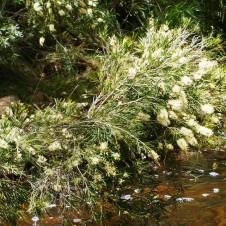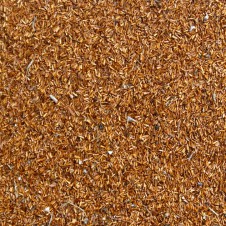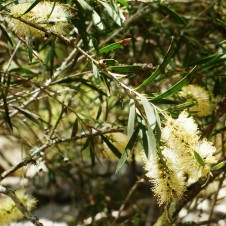General Description: An erect shrub, to 3 m tall, with narrow leaves and pale yellow or pink, ‘bottle-brush’ flower spikes. Has willowy appearance with numerous, slender and often drooping branches. The leaves are grey-green and tapering at both ends, young leaves are silky and have a red colour.
Flowers and Fruit: Pale yellow or pink flowers, in dense ‘bottle-brush’ spikes in upper parts of younger branches from November to January. Fruit isCup-shaped, woody capsules, to 5 mm across, clustered in groups along older branches.
Site Preference and Tolerances: Usually amongst rocks along edges of rivers especially in fairly open valleys. Prefers moist soils but is suited to most soil types including those high in clay. A very hardy and adaptable species which can tolerate severe waterlogging, poor or acidic soils and also dry situations.
Life Span: Fast growing and long-lived (80+ years)
Wildlife Value: Attracts both seed-eating and nectar feeding birds and mammals. Specimens with a dense canopy provide protected nest sites for birds. Flowers provide food for butterflies, moths and other insects which in turn attract insect-eating birds. Nectar is provided for birds and mammals over summer.
Other Values and Uses: Is fast growing and responds well to pruning which can promote denser growth as well as an increase in the number of flowers. Tolerant of fire. A useful species for the control of erosion, especially on streamsides, drainage lines and valley-side seeps.
Other Scientific Names: Callistemon paludosus
Germination Information: Can be propagated easily from seed and will direct seed well if weeds are controlled. Usually germinates in 2-5 weeks.



